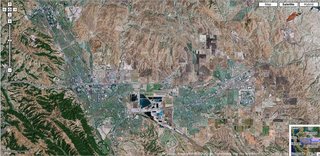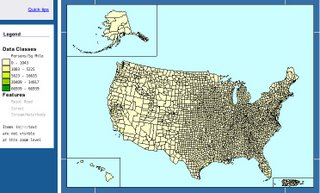Pick a Lie: They aren't making any more land, buy now or get priced out forever

Flagstaff is land-locked. Las Vegas is land locked. The Bay Area is land locked. The satellite picture (from Google Maps) is of the Tri Valley, east of the San Francisco Bay, but west of the Central Valley. The undeveloped land seen in the picture is mostly quite developable, except for the artificial development restrictions. I'm not going to argue about whether it should be developed, I just want to point out that we're not short of land, we just are choosing to allocate it to other purposes.
The maps (from the Census Bureau) are population density by state and by county for the U.S., and by county for Southern California. The country is full of land. People choose to live near other people. Maybe it's the beach. Maybe it's the trendy clubs downtown. That makes land more valuable. I get that. The strange thing about manias is that people will be priced out (for, like "ever"), then go far away to find land (and they usually find it pretty easily when you come to think of it). Then they overpay for it, assuming that their local scarcity will soon be repeated in the near future in this new place. Perhaps someday, but people don't understand that area scales as the square of the distance. Get a little into the countryside, and all the dirt is the same, or nearly so. Moreover, there's acres and acres of it. Especially if you're going to put up tract houses in order to maximize your return.



To be certain, there are and have been local, temporary scarcities of land. Europeans came to the Americas because of misallocation of land as much as because of density pressures. In England, the principle of primogeniture caused massive misallocation of lands. I don't think the U.S. has that problem yet. Nobody can predict the future, so I don't know how long we have until that's our problem. Maybe we'll stop short of irrecoverable misallocation. We have plenty of land, and we can therefore afford to pave some of the world's most fertile soils for houses.

